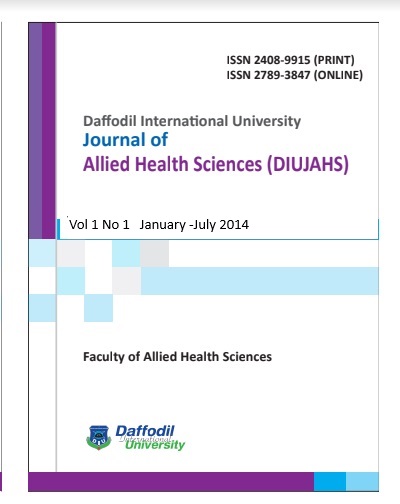Diabetes Distress among type 2 Diabetic Patients
DOI:
https://doi.org/10.36481/diuhls.v01i1-2.15fk5f34Keywords:
DD (Diabetes Distress), DM(Diabetes Mellitus), Diabetes Distress Scale, Glycemic IndeAbstract
A cross sectional study is carried out among 165 adult type 2 diabetes patients attending at the outpatient department of Bangladesh Institute of Research and Rehabilitation in Diabetes, Endocrine and Metabolic Disorders (BIRDEM) Dhaka. Sample is taken purposively. Data are collected through face to face interview and records review. Diabetes distress scale (DDS 17) was measured cut-off value of <2 for little or no distress 2-2.9 for moderate distress and >3 for high distress. It wes observed that 22.42% had high distress,26.1% moderate distress and rest of the 51.5% had little or no distress. The average score of total diabetes distress is 2.17 ± 0.75. The average score of each domain such as emotional burden physician related distress, regimen–related distress and interpersonal distress is (3.49± 1.52), (1.13±0.32), (2.12±0.85) .“Emotional Burden” is considered as the most important domain in measuring diabetes distress. The influence of age on level of diabetes distress is statically significant (p<0.001). The distress scale gradually increase higher from 40 years and continue till 59. The influence of residential status on level of diabetes distress is also statically significant (p<0.001). Respondents from sub-urban areas suffered more distressed symptoms than those from urban areas (53.3% vs.45.7%). The influence of smoking on level of diabetes distressed is statistically significant (p<0.005). Respondents who were the members of the having ever smoker group had highest percentage of distressed symptoms (58.5%). The influence of BMI on level of diabetes distressed is statistically significant (p<0.001). Respondents who were the members of the obese group had highest percent of distress symptoms (100%) they also the group of experience highest percentage of high distress (83.3%). There is a strong positive correlation between two variable [r=0.64,p<0.001] ; diabetes distress score with duration of diabetes mellitus. The influence of duration since detection of diabetes mellitus on level of diabetes distress is statistically significant (p<0.001). Respondents who were having diabetes of >10 years had highest percentage of distressed symptoms. Diabetes distress showed significant relationship with glycemic status. Respondents who were the members of the insulin group had highest percentages of distressed symptoms. The influence of diabetic complication on level of diabetic distress is statistically significantly (p<0.001). Respondents who were the members of having complications group had highest percentage of distressed symptoms.

